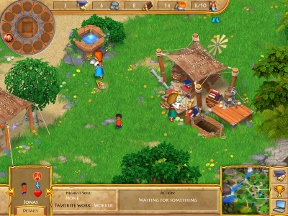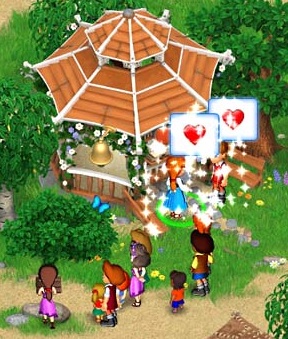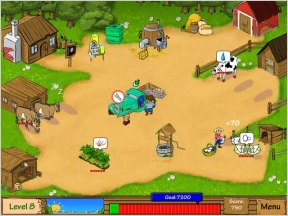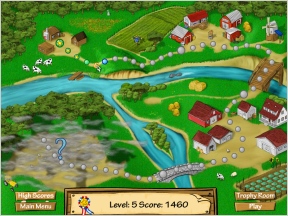 Just like any casual sim title, you'll need to manage each villager and set him or her to work harvesting materials, building structures, researching scientific advancements, and so on. This not only maintains your tribe, it allows them to grow both in number and in intellect, opening up new paths for you to explore and allowing you to develop the tools needed to retrieve the zodiac tiles.
Just like any casual sim title, you'll need to manage each villager and set him or her to work harvesting materials, building structures, researching scientific advancements, and so on. This not only maintains your tribe, it allows them to grow both in number and in intellect, opening up new paths for you to explore and allowing you to develop the tools needed to retrieve the zodiac tiles.
First on the list: food. Everybody's gotta eat, right? Since there doesn't seem to be a McDonald's in sight (if you can call that food), you'll need to work the garden. Drag and drop villagers onto locations and they'll automatically start working. Each character has a favorite activity (building, farming, science, etc.), and they'll be thrilled if you assign them a task they already enjoy. So thrilled, in fact, they'll work faster, which is a huge bonus when your population is low and resources spread thin.
After your food supply is secure, it's time to harvest wood and stone, both useful for building structures. The science hut and chapel, used for researching new technology and marrying couples (first comes love, then marriage, then a population-expanding baby carriage!) respectively, also need to be completed.
Once the basics are taken care of, Gemini Lost opens up its world for you to explore. Look around the map for anything that looks slightly out of place. Then, drop a villager there and see what you need to research in order to solve the mystery. Scientific advancements will eventually allow you to build more things, accomplish bigger tasks, research complex tools, and even mix potions that have a variety of game-altering effects.
 Analysis: Gemini Lost is one part village sim, two parts exploration. It takes some of my favorite aspects from Virtual Villagers and Sprouts Adventure and creates a game that's both relaxing and intriguing at the same time. Want to see what the deal with that rock island is? Try building a raft. Those bees looking interesting? Drop someone there, see what's going on. Your only real limitation is time, as you often have to wait for certain technologies to become available before accessing a new area. Otherwise, the land is yours to roam.
Analysis: Gemini Lost is one part village sim, two parts exploration. It takes some of my favorite aspects from Virtual Villagers and Sprouts Adventure and creates a game that's both relaxing and intriguing at the same time. Want to see what the deal with that rock island is? Try building a raft. Those bees looking interesting? Drop someone there, see what's going on. Your only real limitation is time, as you often have to wait for certain technologies to become available before accessing a new area. Otherwise, the land is yours to roam.
Gemini Lost has a number of player-friendly features that take some of the work out of playing. For starters, the game takes place in real-time, meaning your villagers are hard at work even while you're away. Each time you quit the game, a small menu pops up asking what speed you want things to continue while you're gone. If you aren't planning to play for a few days, set things to "slow" so you don't come back to a village of skeletons.
Navigating through your villagers is a bit tedious, as the only method of quick selection involves scrolling through a list of people one by one. Fortunately, these people tend to take care of themselves and stay pretty busy, so you won't have to do too much babysitting to make sure work gets done.
A pleasantly stunning entry into the casual simulation genre, Gemini Lost is the most player-friendly village management game around.
Review by JohnB
CasualGameplay
 Analysis: Dairy Dash won't stand out as one of the flashiest or innovative resource management games around, but you'll love it for its simple, sweet and rewarding gameplay. Everything about this game is basic, from the simple soundtrack to the gameplay and no-frills visuals, but it all works together surprisingly well.
Analysis: Dairy Dash won't stand out as one of the flashiest or innovative resource management games around, but you'll love it for its simple, sweet and rewarding gameplay. Everything about this game is basic, from the simple soundtrack to the gameplay and no-frills visuals, but it all works together surprisingly well. 
